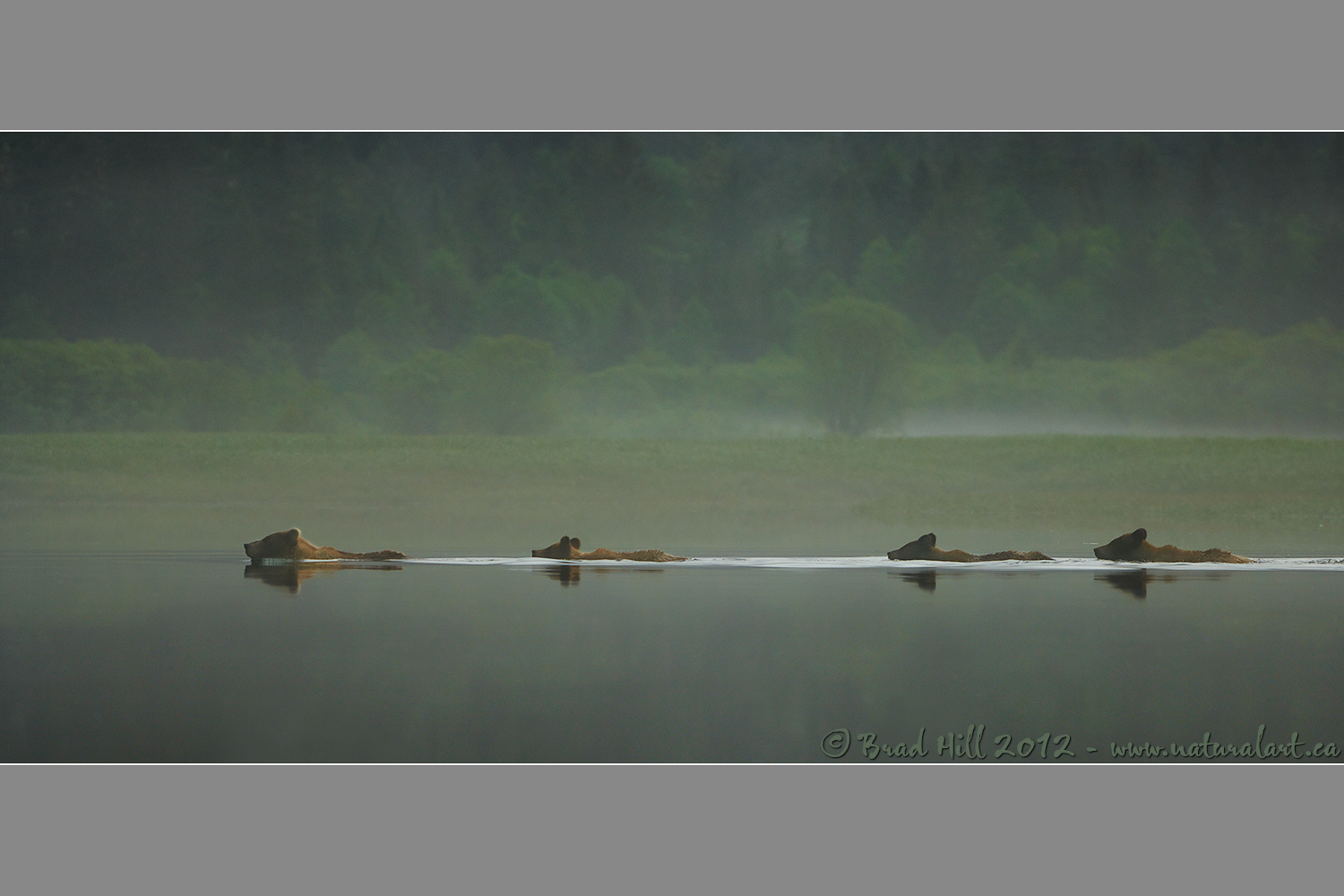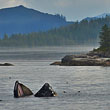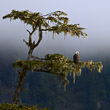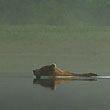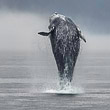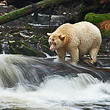Availability: Limited Edition Print - info coming soon!
In the Field
Swimming in Solitude. Khutzeymateen Inlet (Great Bear Rainforest), BC, Canada. June 4, 2006.
This "old" animalscape* is from the first trip I made into the Khutzeymateen Inlet way back in 2006. Watching this family of grizzlies slowly and peacefully swimming across the estuary at the head of the inlet was an exceptionally special and fateful moment for me. I was already taken by the region, but when this scene unfolded right in front of me I knew I was hooked. Since that moment I have been visiting the Khutzeymateen and the Great Bear Rainforest annually - first "simply" as a photographer and then, for the past several years, I have had the privilege of introducing other photographers to the region through my photo tours.
It's hard to put into words how special both the Khutzeymateen Inlet and the entire Great Bear Rainforest is. They're lands of extremes - the weather can be absolutely frightful with storms of epic proportions (mostly in the winter). But, during periods of calm, there's an almost overwhelming aura of peace and tranquility. Because the Khutzeymateen Grizzly Sanctuary is closed to the public (and to hunting) it has very, very few human visitors (under 200 per year!) and the feeling of solitude is absolutely palpable. Both the wildlife and the sparse human visitors are - both literally and figuratively - swimming in solitude.
For a wildlife photographer there's one other characteristic of the Khutzeymateen that makes it absolutely unique - thanks to the caution and respect the guides working the region have shown the wildlife over the past two decades, most of the animals have come to trust and accept humans almost completely. While not at all tame, the bears and other wildlife largely ignore the human visitors and share virtually all aspects of their daily lives with the odd two-legged "up-rights" that quietly ride around in inflatable boats! It's bear - and wildlife photographer - heaven!
About this shot. Well, this is a bit of an embarrassing admission, but I somehow managed to "miss" seeing (and processing) this image until late January of 2012 (despite shooting it in 2006!). While preparing a seminar on wildlife photography I found myself in need of an image demonstrating how strong lines naturally occuring within the scene can guide both one's composition and the orientation (vertical vs. horizontal) used on the original capture. I'm anal about the keywording of my image files and simply typed in "horizontal line" and "composition" and "poof" this image came up (in raw, unprocessed form). Although on a tight timeline, I couldn't resist the urge to take the few minutes needed to process the final image.
So here ya go - and oldie, but I think a goodie...
Some may enjoy seeing a larger version of this shot - so here's a 2400 pixel version of it:
• Swimming in Solitude: Download 2400 pixel image (JPEG: 0.79 MB)
ADDITIONAL NOTES:
1. This image - in all resolutions - is protected by copyright. I'm fine with personal uses of it (including use as desktop backgrounds or screensavers on your own computer), but unauthorized commercial use of the image is prohibited by law. Thanks in advance for respecting my copyright!
2. Like all wildlife photographs on this website, this image was captured following the strict ethical guidelines described in The Wildlife FIRST! Principles of Photographer Conduct. I encourage all wildlife photographers to always put the welfare of their subjects above the value of their photographs.
*3. For a more detailed discussion of the image types I call animalscapes and enviroscapes (and the subtle distinctions between them), just go here...
Behind the Camera
Swimming in Solitude. Khutzeymateen Inlet (Great Bear Rainforest), BC, Canada. June 4, 2006.
Digital Capture; RAW 14-bit format; ISO 200.
Nikon D2x with Nikkor 200-400 f4 VR @ 250mm (EFL of 375mm). Hand-held from floating Zodiac. VR on and in "Normal" mode.
1/750s @ f4; no compensation from matrix-metered exposure setting.
At the Computer
Swimming in Solitude. Khutzeymateen Inlet (Great Bear Rainforest), BC, Canada. June 4, 2006.
RAW Conversion to 16-bit TIFF, including first-pass/capture sharpening using Phase One's Capture One Pro 6. Three exposure variants covering a 0.7 stop total range, from -0.4 stops below original capture (to tame reflections in the foreground water) to 0.3 stops above original exposure (for a few shaded regions on the bears and the distant background).
Further digital corrections on resulting 16-bit TIFF files using Adobe's Photoshop CS5. Photoshop adjustments including compositing (layering and masking) the exposure variants using both luminosity and manual masking techniques, selective colour saturation, selective adjustment of mid-tone contrast (to background forest) and selective sharpening for web output.
Conservation
Swimming in Solitude. Khutzeymateen Inlet (Great Bear Rainforest), BC, Canada. June 4, 2006.
Ten percent of the revenue generated by this image will be donated to Raincoast*.
Species Status in Canada**: Special Concern (May 2002).
While Grizzly Bears (Ursus arctos) are not technically listed as "Endangered" in Canada, they have been extirpated from most of their historical range. Grizzly Bears are far more sensitive to intrusion/disturbance in their habitat than are Black Bears and are being increasingly forced into marginal habitat by human encroachment. The Great Bear Rainforest along the central and northern coast of British Columbia is one of the last strongholds of the Grizzly Bear in Canada, and even this population is coming under increasing pressure.
On December 18, 2017 the government of British Columbia banned grizzly hunting across the entire province. This major conservation victory came after decades of tireless work by many dedicated conservationists and ecologists and, most importantly, it reflects the opinion of the vast majority of British Columbians. And, it means that AT LEAST while the current government remains in power grizzlies are finally "safe" in British Columbia.
Now that we've at least temporarily won the battle to save grizzlies in BC, it's time to re-focus our efforts toward protecting ALL of BC's carnivores, including Gray Wolves, Black Bears, Cougars, Wolverines, and more! Simply put, there are no ecological, economic, or ethical arguments supporting the trophy hunting of carnivores.
In a great first step towards ending the hunting of carnivores throughout BC the Raincoast Conservation Foundation has developed a program designed to protect ALL carnivores within the Great Bear Rainforest. Details about this program can be found on this page on Raincoast's website. Check it out and, better yet, make a donation to help Raincoast purchase the remaining commercial hunting tenures in the Great Bear!
*The Raincoast Conservation Society (and Foundation) is an effective and efficient organization that has been fighting for protection of this unique habitat. If you are looking for a meaningful way to contribute to the conservation of this amazing ecosystem, Raincoast will provide maximal "bang" for your conservation dollars.
**as determined by COSEWIC: The Committee on the Status of Endangered Wildlife in Canada













